A camera is first and foremost a device for taking pictures. Sometimes, those pictures become iconic pieces of art. The great thing about photography is that while we can’t buy Leonardo Da Vinci’s brushes or Michelangelo’s chisels, we can still buy or at least dream of the cameras used by legendary photographers with which they created their art pieces. We dream of Henri Cartier-Besson’s Leica, Astrid Kircher’s Rolleicord, or, like me, Pennie Smith’s Pentax ES II.
I happen to like things from decades before my time like vintage cars, mechanical typewriters, cameras (that’s obvious, isn’t it?) and: punk rock. So when I read in an article on Kosmo Foto that “the” album cover (London Calling – The Clash, released when I was seven) was shot with a Pentax ES II, I had to get one. Which ended up being two. Due to lack/knowledge of flea markets and thrift stores in our new neighbourhood, I intensified my online search for cameras and after a medium long search I found a silver Pentax ES II with the kit lens, a Tamron Zoom and a Vivitar tele-converter, I bought it. It even came with the original manual.
But, sadly, the light meter did not work. Although it’s not necessary, as the camera can work completely mechanically, the “electronic shutter” is what helped take the picture I mentioned, so I tried to get it repaired, but to no avail. After a year in service, I gave up and bought another body as a “spare part” and this simple “repair” worked 🙂
About the Asahi Pentax ES II
The Pentax ES II is the last model of the Spotmatic series and the last Pentax SLR with a featuring m42 lens mount. It’s a typical SLR from the ’70s: solid, quite big (especially compared to my Olympus OM-1n) with a cloth shutter, an M42 lens mount, self-timer, tripod mount and a hot shoe as well as two PC sync connectors for flashguns.
The first Spotmatic released in 1960 was the first SLR featuring Through The Lens (TTL) metering, which meters unlike other cameras which had no light meters at all or selenium/CD meters next or above the lens (e.g. my Kodak Retina Reflex S or the Zenit 11) the light reflected by the subject through the current lens. The Pentax Spotmatic was an instant success, and a second-hand Spotmatic was used by Roberta Bailey to shoot another famous cover for the greatest band of all time: the cover of the first Ramones album. (which you can see on a memorial plate on Tommy Ramone’s Birthplace in Budapest, around 100m from the place I bought my Zorki 4)
In 1970, the Electric Spotmatic was released, the first camera with an aperture priority electronic shutter. In 1973, the ES II was released, and with it the possibility to meter with an open lens, as long as SMC lenses were used. Those lenses have an additional pin, which “tells” the camera’s electronics in a manual way which aperture is selected on the lens (Other M42 lenses can be used as well, but have to be stopped down).
The camera needs 4 (yes, four) LR/SR 44 batteries for the light meter and the electronic shutter, but works with limited (compared to other SLR of that time but still more than on the Zenits) exposure times fully manual without batteries as well.
Like other cameras of this era, the Pentax ES II was available in silver or black, and although I usually prefer silver cameras because I like the metal finish, the ES II just looks “cooler” in black, and I especially like the edges where the brass starts to show.
Taking pictures with the Asahi Pentax ES II
The first step to use any of the more complicated electronic SLRs of the 70ies is to read the manual. Then put 4 batteries in the compartment under the lens barrel and test if the light meter works. If not, you still have a beautiful manual camera for M42 lenses, but you have to measure the light in another way (external light meter, smartphone app, sunny f 16 rule) and you are limited to the mechanical shutter speeds of B, 1/60, 1/125, 1/250, 1/500 and 1/000. If the light meter works, you have any shutter speed between 1/1000 and 8 seconds, even if it is 1/572.
Film loading works “as usual”: open the back by lifting the rewind crank, enter your film, close, advance the film & check if the crank is moving. To select the film speed (ASA 20 – 3200), lift the ring around the rewind crank. When you lift the crank again, you can move the film marker and set it to black & white, natural or artificial light or “EMP.” for empty.
To shoot in automatic mode, turn the speed dial to the arrow symbol and make sure that the stop down lever is up when using an SMC lens or down for normal M42 lenses. Now gently depress the shutter release and the light meter needle in the viewfinder will show the expected shutter speed depending on your chosen aperture. If you want to compensate for front light or dark backgrounds, use the dial around the rewind crank and choose a compensation (4x, 2x, 1, 1/2).
For low light long exposures, you can close the shutter window with the speed dial, selecting the symbol “above” the arrow to avoid misreadings of the meter. For flash photography, connect a flashgun and set the shutter speed to 1/60. The self-timer is loaded with the black lever on the front, to release press the silver one beneath of it.
One button left unexplained: the small button on the top left of the camera, which is the battery tester. When pressed, the light meter index should fall to the middle.
To rewind, again, as usual: press the button on the baseplate, rewind and remove the film.
The Asahi Pentax ES II is an iconic camera, used by Photographers as well as Rock Stars & Astrophysicists. While I will never create a famous art piece with it, at least I have the right tool now.
P.S. Here’s the incredible article from Stephen Dowling about the camera, the Clash, Pennie Smith and even the Manic Street Preachers another great band and at least from my time.
Pentax ES II: The camera that captured rock’s most iconic photograph
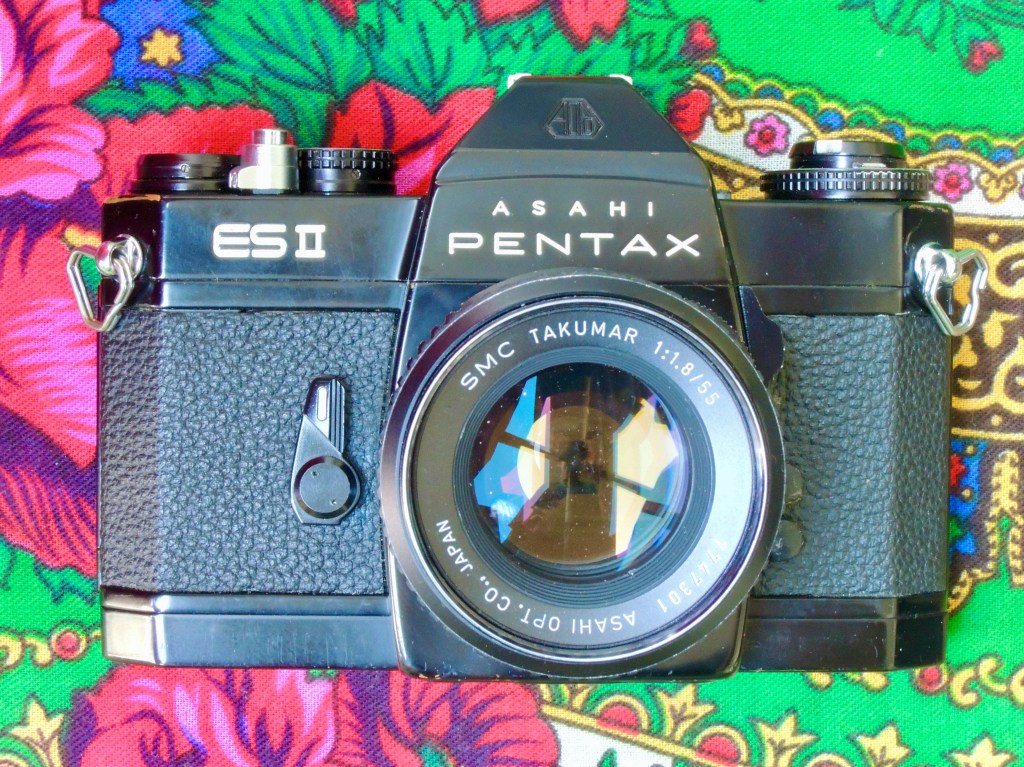
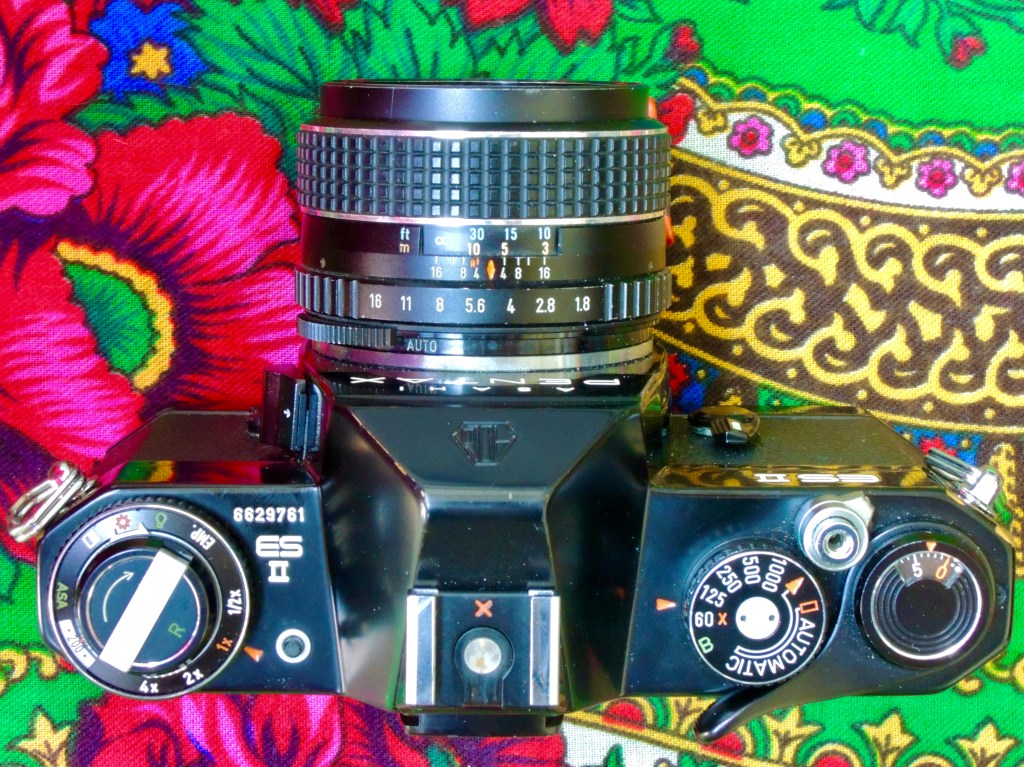

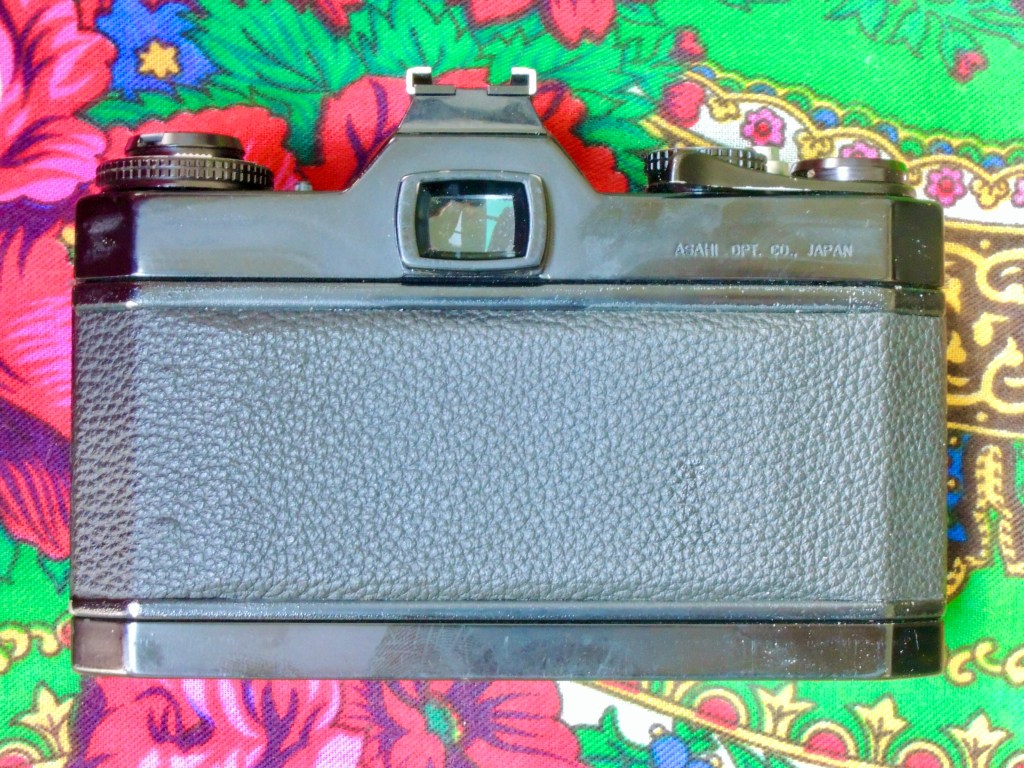

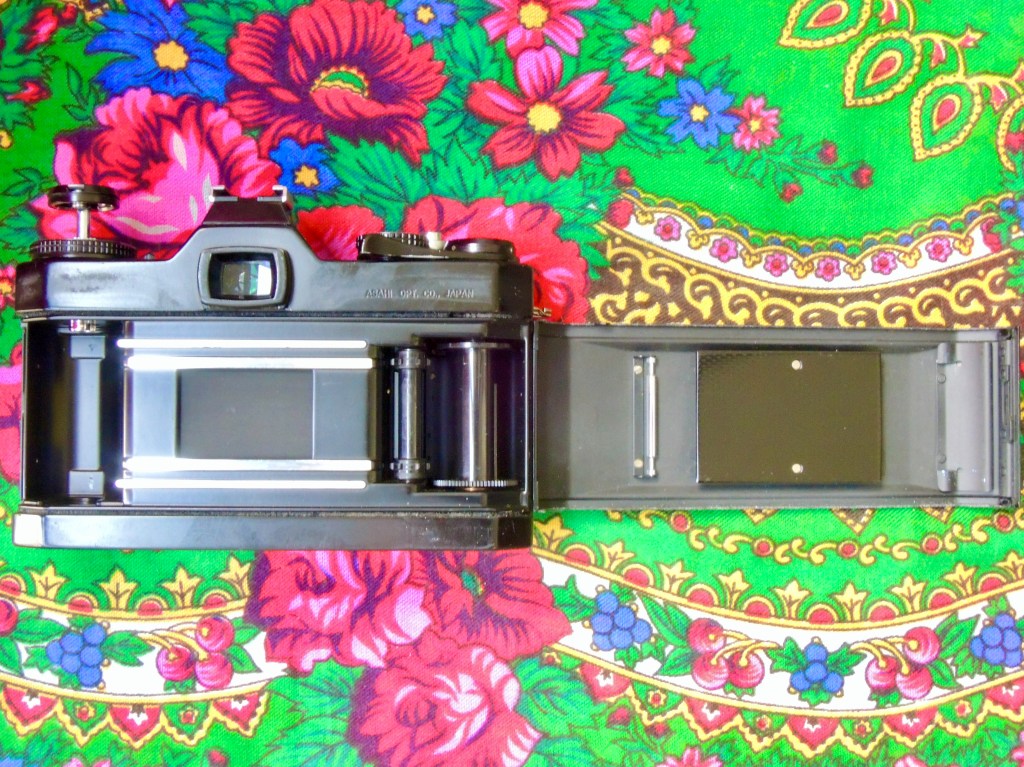
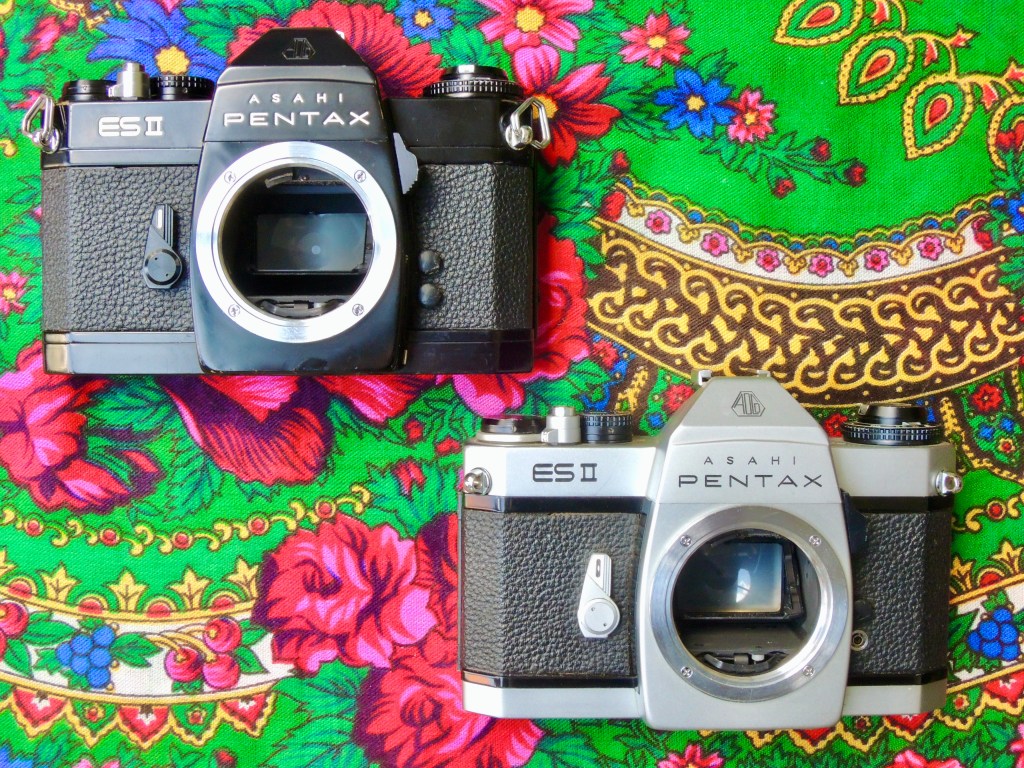
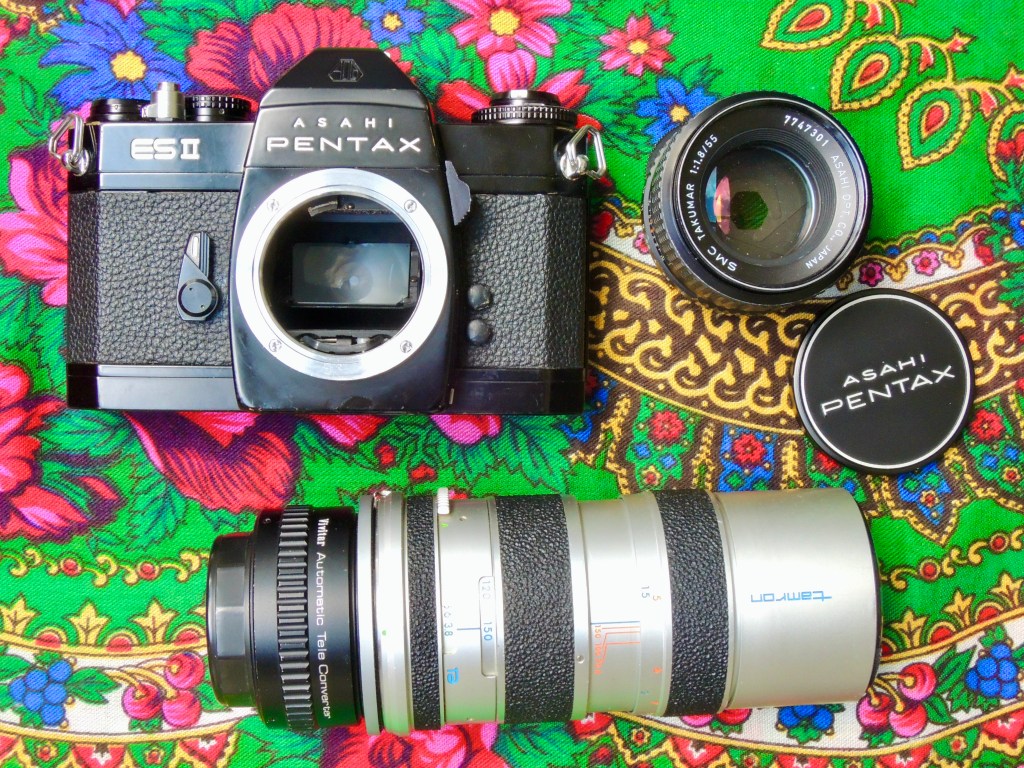




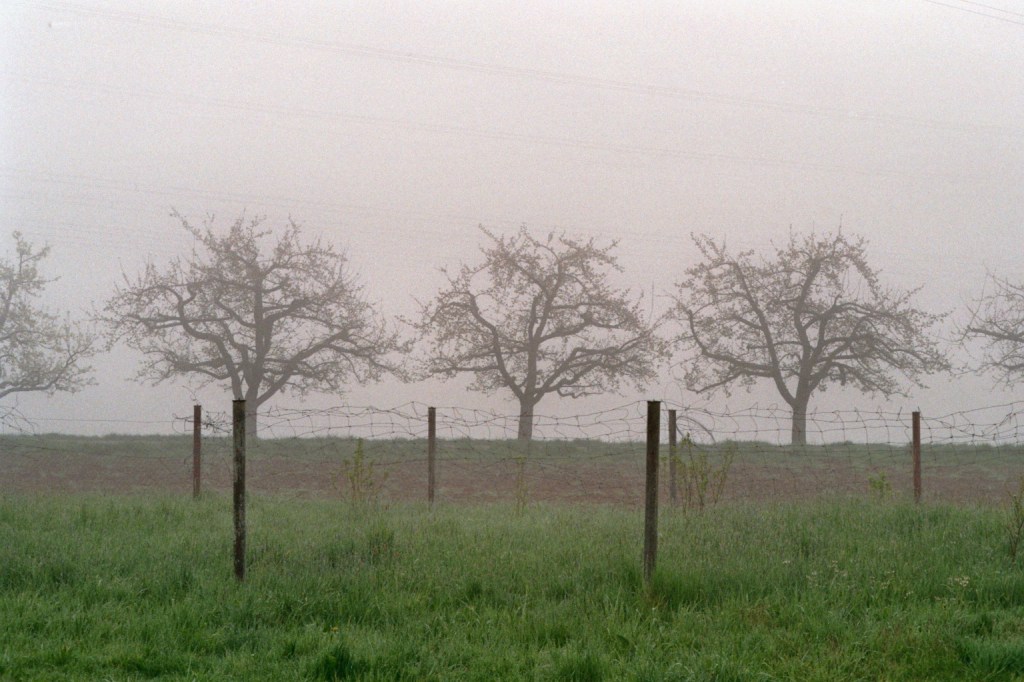





| Brand | Asahi Pentax |
| Model | ES II |
| Year built | Unknown, the cameras were produced between 1973 and 1975 |
| Serial number | 6683219 (silver, light meter broken) 6629761 (black, working) |
| Lenses | Asahi SMC Takumar 1:1.8/55 7747301 Tamron 1:35/70~150mm 5612369 Vivtar Tele Converter 2x-8 |
| Shutter | Curtain Shutter |
| Film format | 35mm |
| Special features | Electronic Shutter with “flexible” speeds (1/342 1/754 whatever needed) |
| Accessories | – |
| Manufactured by | Asahi Optical Co., Ltd. |
| Date of purchase | 03/2022 (silver) 04/2023 (black) |
| Price | 105 € (silver body, 2 lenses & converter, manual) 61,80 € (black body) |
| Place of purchase | eBay classified and eBay |
Tips & Tricks shooting with the Pentax ES II
There are mixed reports regarding the battery life, but even the manual suggests selecting one of the manual speeds to deactivate the meter’s circuit to make them last a little longer.
Film purchase & processing
The camera can use any type of 35mm film, to re-create the iconic shot mentioned above pushing ASA 400 to 3200 could be considered.
Useful Link
https://www.butkus.org/chinon/pentax/pentax_esii/pentax_esii.htm (The manual)
https://www.instructables.com/How-to-fix-a-ceased-mirror-on-a-Pentax-ES-Spotmati/ (Repair guide for locked up mirrors, did not help my silver body, but maybe you have more luck)
https://blog.jimgrey.net/2015/05/25/pentax-es-ii/ (Jim Grey’s review)
https://kosmofoto.com/2023/04/pentax-esii-camera-review/ (Review on Kosmo Foto)
https://kosmofoto.com/2019/09/pentax-esii-the-clash-london-calling/ (The review which caused this article.)
Pictures
Asahi Pentax Spotmatic Pool on Flickr
My pictures on Flickr


One thought on “The Asahi Pentax ES II”